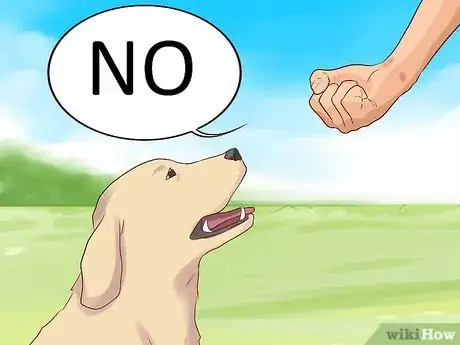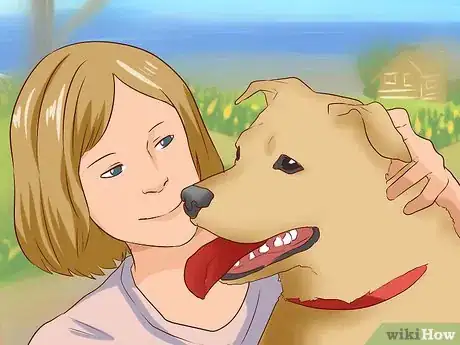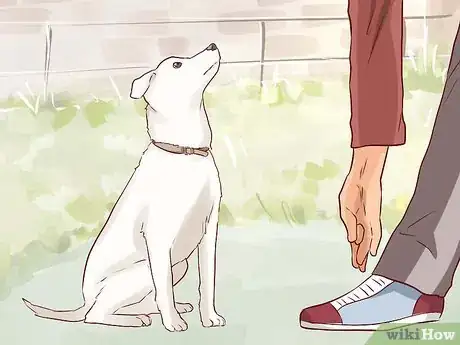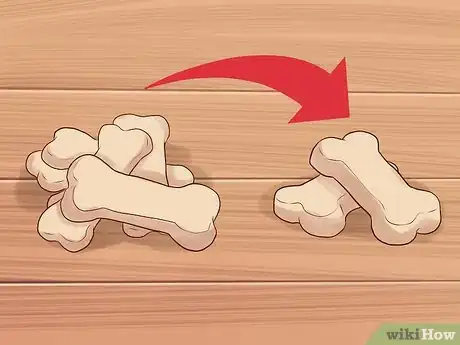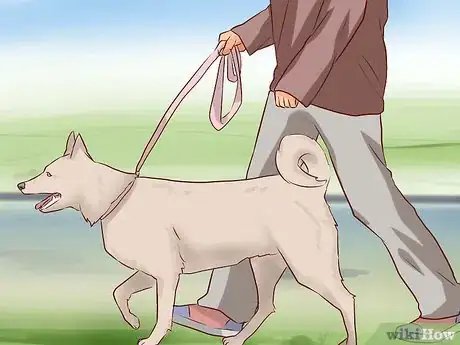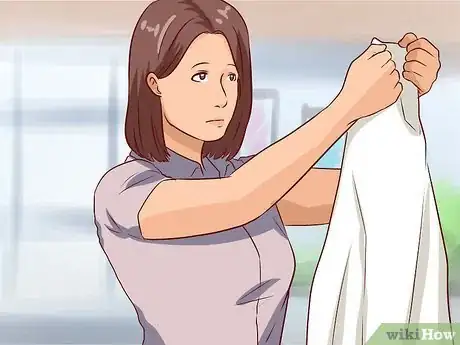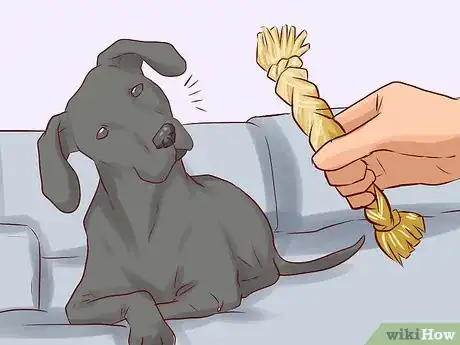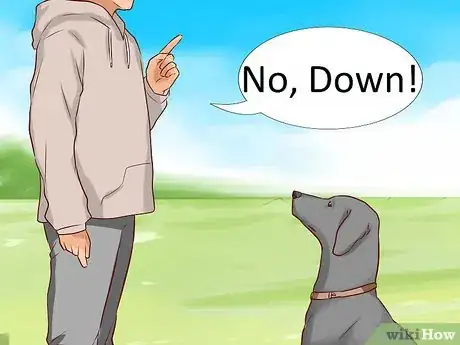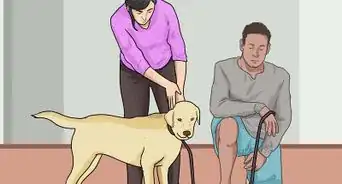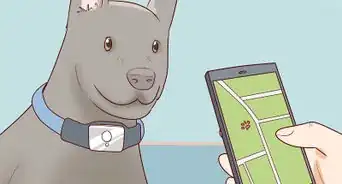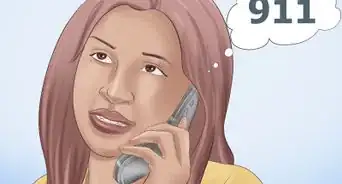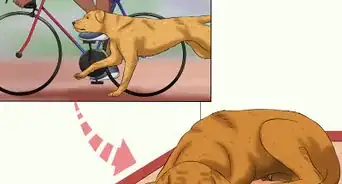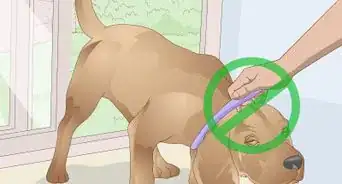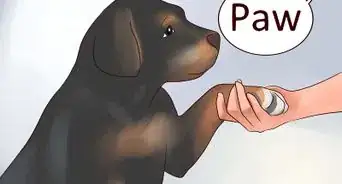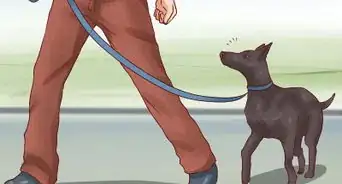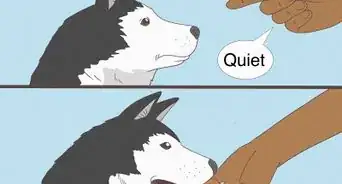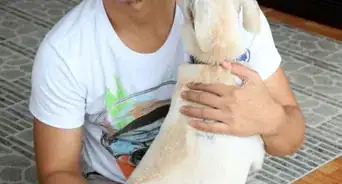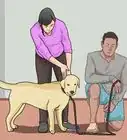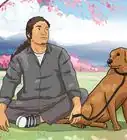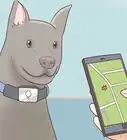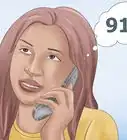This article was co-authored by David Levin. David Levin is the Owner of Citizen Hound, a professional dog walking business based in the San Francisco Bay Area. With over 9 years of professional dog walking and training experience, David's business has been voted the "Best Dog Walker SF" by Beast of the Bay for 2019, 2018, and 2017. Citizen Hound has also been ranked #1 Dog Walker by the SF Examiner and A-List in 2017, 2016, 2015. Citizen Hound prides themselves on their customer service, care, skill, and reputation.
wikiHow marks an article as reader-approved once it receives enough positive feedback. In this case, 87% of readers who voted found the article helpful, earning it our reader-approved status.
This article has been viewed 275,244 times.
One of the first lessons your puppy or dog should learn is that “no” or “leave it” means to stop doing what it is she is doing before she hurts herself, hurts you or someone else, or destroys property. This command will help your dog learn a little self-control and make her a good member of the household.
Steps
Teaching Your Dog the Command
-
1Show your dog the behavior. The goal of teaching your dog any command is to help her associate the command with the desired behavior while strengthening the connection with positive reinforcement. To teach her “no” or “leave it,” begin by showing her the behavior you want.
- For example, show her a treat in your hand, and then say “no” before closing your fist around the treat. Let her sniff and lick at your hand, but don’t give her the treat. Once she stops trying and turns away, offer her plenty of praise and provide a treat from your other hand—not the enclosed one.[1]
- Use a stern voice to issue the command, but don’t yell or otherwise make your dog think you’re punishing her. Use a neutral, stern voice as opposed to the happy voice you usually use with your dog, so she doesn’t mistake the command for positive reinforcement.
-
2Have patience. You can anticipate repeating this exercise ten times or even more before your dog understands that she gets the treat by leaving your closed hand alone.[2] Stay patient with the process, and always offer plenty of praise when she eventually leaves the closed hand alone (shows the desired behavior).
- Space the trials out as well to stop both of you from getting frustrated. Try a few times a day over the course of several days.[3]
Advertisement -
3Watch your body language. Your dog will understand body language just as much as a command. Stand tall and issue the command in an authoritative voice, but don’t try to scare your dog. You want her to want to understand and obey the command instead of simply frightening her.
-
4Teach your dog to look at you to earn the treat. You don’t just want your dog to leave the object alone, but you want her to turn her attention to you when you issue the command. This will allow you to tell her “no” to stop a behavior but then also “come” in case the object you want her to leave is dangerous, for instance. Once she understands that “no” means to leave the object alone, you can add more complexity to the command to turn her attention to you.
- Instead of immediately offering praise when she turns away from your enclosed fist, don’t say or do anything. Since this isn’t what she expects to happen, she’ll look up at you for instruction. As soon as she does, offer the praise and the treat (still from your opposite hand).[4]
- Repeat the exercise until your dog immediately looks up and makes eye contact with you when you say “no” instead of staring at your fist for several seconds before looking to you. This may require lots of repetitions—up to forty or fifty.[5]
- You can make her focus and show even more self-control by slowly increasing the amount of time she needs to keep eye contact with you before offering the praise and treat.[6]
-
5Teach your dog to obey the command with the treat on the floor. “No” is easier when your dog can’t reach the treat anyway (when it’s in your fist). The next step is to place the treat on the floor with your hand guarding the treat rather than completely enclosing it.[7] You may have to start with your hand completely around the treat, but over several repetitions, begin lifting your hand until she stops when you say “no” even with the treat in the open.[8]
- To help make this successful, use a treat she likes but doesn’t love on the floor. Reserve her favorite type of treat for when you provide the praise and treat when she leave the one of the floor alone.[9] Be very consistent with the positive reinforcement.
- Remember that you should wait to provide the treat until your dog looks at you when you say “no.”[10]
- The process will require patience and lots of repetitions.
-
6Practice out in the real world. The final test for your dog is to ensure that she can still repeat the behavior in a less controlled environment. Begin using the command in a variety of other settings instead of just in the home. Tell her “no” outside while other exciting things are going on. When she regularly obeys under these circumstances, that’s when you know she has full command of the order.
- For instance, hide a treat along your walking path before you actually take your dog out for a walk. When she gets a whiff of it and begins heading toward it, issue the command and keep walking. If she pulls at her leash toward the treat, then stop out of range. Wait for her to stop pulling and to look up at you, then offer plenty of praise and give her a treat from your pocket—not the one you planted.[11]
-
7Reduce the dependence on treats. As your dog begins obeying the command regularly, decrease the instances where you provide a treat while still providing all of the praise for obeying the order. She will continue to obey even if you only provide a treat once every four or five times she responds to the command as long as you remain consistent with the other aspects of positive reinforcement.
Taking Additional Steps to Help Your Dog
-
1Give your dog plenty of exercise. A rambunctious dog full of pent-up energy is much more likely to disobey or have self-control issues. Aim to give your dog a thirty-minute walk each day at a brisk pace for active breeds.[12]
-
2Remove the offending item or source of behavior. You simply cannot always be around to tell your dog “no,” so set her up for success by removing the items she’s not supposed to get into. Put plants and fragile items on high shelves, keep shoes behind a door, and keep clothing off the floor.
- This is also a great precaution to take even when you are home while she’s still learning the command and doesn’t yet always obey.
-
3Distract your dog. Once your dog understands and obeys “no,” then she’ll know to resist the temptation of the forbidden object, but only for a short time. Rather than telling your dog “no” over and over, she to distract her with something else, such as her favorite toy or a walk.[13]
- For instance, say your dog consistently keeps trying to get up on the couch. Rather than saying “no” over and over all afternoon, say it once. Then say, “Where’s your toy?” Proceed to go get her favorite toy and toss it or play tug-o-war with it for a moment. Her attention will shift away from the sofa.
- Distraction is another great step to take while your dog is still learning the no command. Make sure to interrupt your dog before she actually displays the undesired behavior—when she sniffs at the couch or paces in front of it, for example. Otherwise, she might begin to associate you playing with the toy with her as praise for the behavior.
-
4Use prevention techniques. While your dog is still learning or if she’s having trouble with consistency, then you can also use prevention measures. If it is furniture that is a problem (for instance), look for dog repellent sprays such as orange oil or bitter apple and spray around the vicinity of the furniture or objects that the dog seeks out.[14]
- Make sure to check an inconspicuous spot on the object first to make sure the repellent spray doesn’t damage the item.
- There are also electrical mats or chargers that you can place on or around items. If your dog comes in the vicinity (shock collar type) or touches the object (direct contact type), the mat or charger will give the dog a slight shock to deter him from coming in contact with the article.
-
5Teach your dog associated commands. While “no” is a good preventative command to teach your dog, it might not always apply, especially if your dog proceeds to follow through with the behavior anyway. For these instances, it helps also to teach your dog other associated commands that you can use to help her understand the behavior you expect from her.
- For instance, if you tell her “no” before she runs across the yard, but she runs off anyway, then it’s beneficial for your dog to respond to a command like “come.” You can begin teaching this command by saying it before making your dog chase you and then offering positive reinforcement.[15] You can find more information on teaching your dog this command at How to Train a Dog to Come
- Similarly, teaching your dog “down” if she jumps up on people after being told “no” can also help. To do so, completely ignore her as she jumps up on you except for issuing the command “down,” and then give her plenty of treats and praise as soon as all four of her paws are back down on the floor.[16] This is more effective than pushing her off, which she can mistake for play.
Expert Q&A
Did you know you can get expert answers for this article?
Unlock expert answers by supporting wikiHow
-
QuestionIs it okay to tell your dog no?
 David LevinDavid Levin is the Owner of Citizen Hound, a professional dog walking business based in the San Francisco Bay Area. With over 9 years of professional dog walking and training experience, David's business has been voted the "Best Dog Walker SF" by Beast of the Bay for 2019, 2018, and 2017. Citizen Hound has also been ranked #1 Dog Walker by the SF Examiner and A-List in 2017, 2016, 2015. Citizen Hound prides themselves on their customer service, care, skill, and reputation.
David LevinDavid Levin is the Owner of Citizen Hound, a professional dog walking business based in the San Francisco Bay Area. With over 9 years of professional dog walking and training experience, David's business has been voted the "Best Dog Walker SF" by Beast of the Bay for 2019, 2018, and 2017. Citizen Hound has also been ranked #1 Dog Walker by the SF Examiner and A-List in 2017, 2016, 2015. Citizen Hound prides themselves on their customer service, care, skill, and reputation.
Professional Dog Trainer
-
QuestionWhat should you say instead of "no" to your dog?
 David LevinDavid Levin is the Owner of Citizen Hound, a professional dog walking business based in the San Francisco Bay Area. With over 9 years of professional dog walking and training experience, David's business has been voted the "Best Dog Walker SF" by Beast of the Bay for 2019, 2018, and 2017. Citizen Hound has also been ranked #1 Dog Walker by the SF Examiner and A-List in 2017, 2016, 2015. Citizen Hound prides themselves on their customer service, care, skill, and reputation.
David LevinDavid Levin is the Owner of Citizen Hound, a professional dog walking business based in the San Francisco Bay Area. With over 9 years of professional dog walking and training experience, David's business has been voted the "Best Dog Walker SF" by Beast of the Bay for 2019, 2018, and 2017. Citizen Hound has also been ranked #1 Dog Walker by the SF Examiner and A-List in 2017, 2016, 2015. Citizen Hound prides themselves on their customer service, care, skill, and reputation.
Professional Dog Trainer
-
QuestionMy French bulldog puppy is very grumpy in the morning and bites. How do I stop that?
 Community AnswerCurbing bad behaviors is essential during puppyhood, as this is the age that dogs learn the most. Correct your dog with a firm "no" if they nip you. "Firm" does not mean angry. Be calm but unyielding when correcting your dog. To help reinforce no biting, you can clicker train your puppy and use a clicker (or even a pen) to reward your puppy the second they stop biting after your correction, but ONLY when they stop. This teaches them that if they don't bite you, they will be rewarded.
Community AnswerCurbing bad behaviors is essential during puppyhood, as this is the age that dogs learn the most. Correct your dog with a firm "no" if they nip you. "Firm" does not mean angry. Be calm but unyielding when correcting your dog. To help reinforce no biting, you can clicker train your puppy and use a clicker (or even a pen) to reward your puppy the second they stop biting after your correction, but ONLY when they stop. This teaches them that if they don't bite you, they will be rewarded.
Warnings
- If you wait until your dog has already done the bad behavior, or try to scold your dog after the fact, the dog will not associate the two things. Getting in the trash was fun. Being yelled at was not. There's no connection.⧼thumbs_response⧽
- Never hit or otherwise hurt your dog to discourage an unwanted behavior. It may result in the dog being afraid of you.⧼thumbs_response⧽
References
- ↑ https://www.aspca.org/pet-care/virtual-pet-behaviorist/dog-behavior/teaching-your-dog-leave-it
- ↑ https://www.aspca.org/pet-care/virtual-pet-behaviorist/dog-behavior/teaching-your-dog-leave-it
- ↑ https://www.aspca.org/pet-care/virtual-pet-behaviorist/dog-behavior/teaching-your-dog-leave-it
- ↑ https://www.aspca.org/pet-care/virtual-pet-behaviorist/dog-behavior/teaching-your-dog-leave-it
- ↑ https://www.aspca.org/pet-care/virtual-pet-behaviorist/dog-behavior/teaching-your-dog-leave-it
- ↑ https://www.aspca.org/pet-care/virtual-pet-behaviorist/dog-behavior/teaching-your-dog-leave-it
- ↑ https://www.aspca.org/pet-care/virtual-pet-behaviorist/dog-behavior/teaching-your-dog-leave-it
- ↑ https://www.aspca.org/pet-care/virtual-pet-behaviorist/dog-behavior/teaching-your-dog-leave-it
- ↑ https://www.aspca.org/pet-care/virtual-pet-behaviorist/dog-behavior/teaching-your-dog-leave-it
- ↑ https://www.aspca.org/pet-care/virtual-pet-behaviorist/dog-behavior/teaching-your-dog-leave-it
- ↑ https://www.aspca.org/pet-care/virtual-pet-behaviorist/dog-behavior/teaching-your-dog-leave-it
- ↑ https://www.aspca.org/pet-care/virtual-pet-behaviorist/dog-behavior/exercise-dogs
- ↑ Behavior Problems of the Dog and Cat 3: Behavior Problems of the Dog and Cat. G.M. Landsberg, W. L. Hunthausen and L. J. Ackerman. Elsevier. 2013
- ↑ Behavior Problems of the Dog and Cat 3: Behavior Problems of the Dog and Cat. G.M. Landsberg, W. L. Hunthausen and L. J. Ackerman. Elsevier. 2013
- ↑ http://www.aspca.org/pet-care/virtual-pet-behaviorist/dog-behavior/teaching-your-dog-come-when-called
- ↑ https://www.aspca.org/pet-care/virtual-pet-behaviorist/dog-behavior/teaching-your-dog-not-jump-people
About This Article
To teach your dog what "no" means, start by showing it a treat in your hand. Then, say "no" and close your hand around the treat. Next, once your dog stops sniffing and licking your hand and turns away, praise it and give it a treat from your other hand. Repeat this process until your dog learns to stop sniffing or licking your hand when you say "no," and then try the exercise with the treat on the floor instead of in your hand. For more advice from our Veterinary co-author, like how to stop your dog from doing things when you're not around, scroll down!
